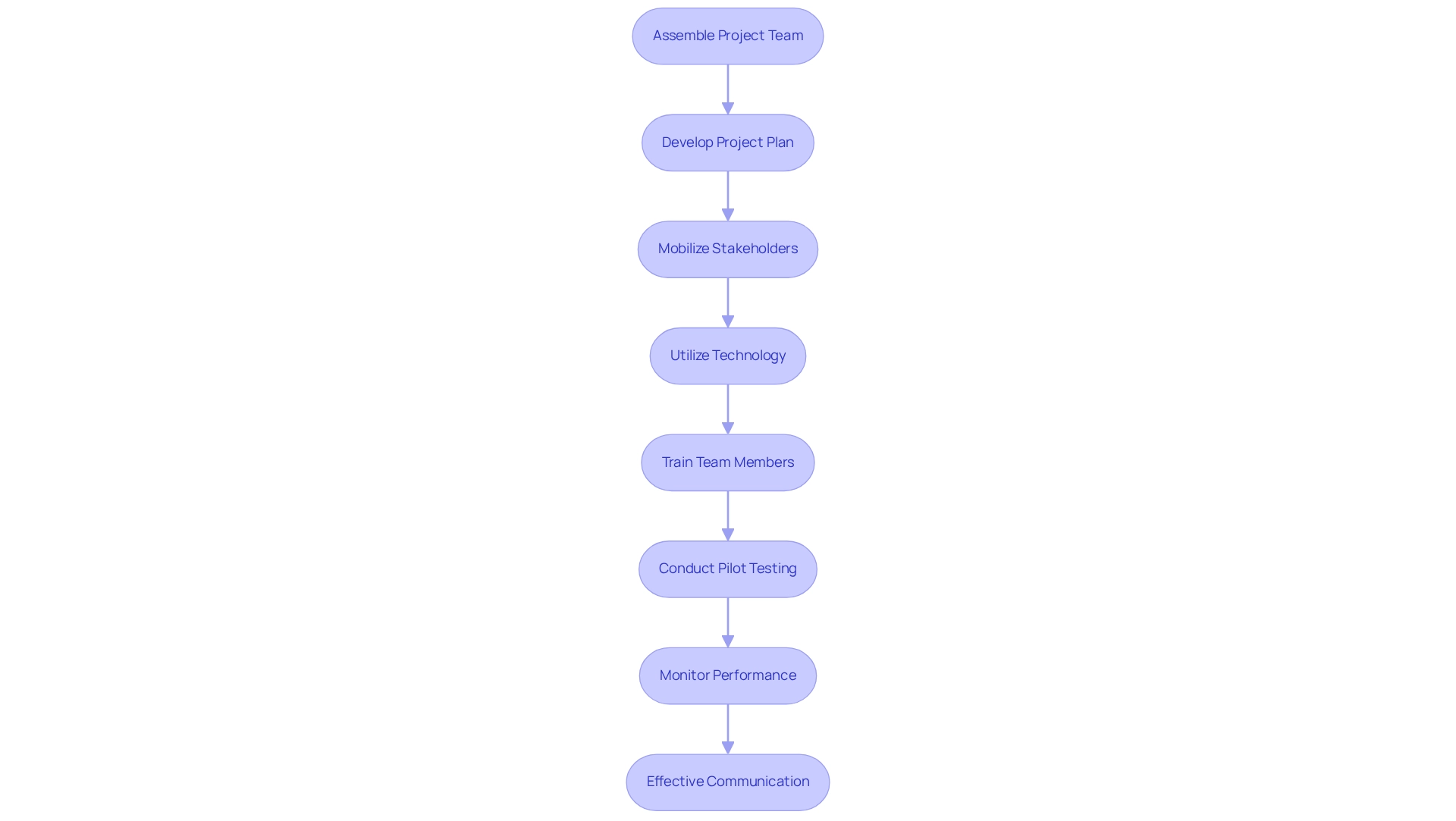Overview
We recognize the critical need for effective healthcare integration solutions in today’s complex landscape. Our article outlines five essential steps for implementing such solutions:
- Assessing current systems
- Selecting the right platform
- Implementing the solution
- Monitoring its performance
Each step underscores the importance of stakeholder engagement, technology compatibility, and ongoing management. By doing so, we enhance patient care and operational efficiency, backed by evidence demonstrating improved outcomes through successful EHR integration and adherence to regulatory standards.
What’s holding your team back from achieving these results? Let us guide you through this transformative journey.
Introduction
In today’s rapidly evolving healthcare landscape, the integration of diverse systems is not just beneficial; it is a critical necessity. As we strive to enhance patient care and operational efficiency, implementing integration solutions becomes paramount. These technologies facilitate seamless data exchange and ensure compliance with regulatory standards, leading to improved health outcomes. Platforms like Avato’s hybrid integration system are revolutionizing our approach to interoperability, effectively addressing the challenges of managing vast amounts of data while maintaining system reliability.
What’s holding your team back from achieving this level of integration? This article delves into the essential steps for implementing effective healthcare integration solutions—from assessing current systems to selecting the right platform and ensuring ongoing management. Together, we can pave the way for a more connected and efficient healthcare environment.
Understand Healthcare Integration Solutions
Healthcare unification approaches present a compelling opportunity to link distinct healthcare networks through a healthcare integration solution that employs advanced technologies and strategies, enabling seamless data transfer and communication. Solutions such as Electronic Health Records (EHR), Health Information Exchanges (HIE), and interoperability frameworks are essential for enhancing patient care, improving operational efficiency, and ensuring compliance with regulatory standards.
At Avato, we recognize the pivotal role our hybrid unification platform plays in this landscape, maximizing and extending the value of legacy technologies. By simplifying intricate integrations, we facilitate real-time monitoring and alerts on performance, which are vital for ensuring 24/7 uptime and reliability in critical sectors like banking and government.
Interoperability stands as a cornerstone in this domain, allowing disparate systems to collaborate effectively. Recent research underscores that organizational interoperability is critical for aligning business processes and policies, ultimately enhancing service delivery. A study conducted in 2022 highlighted the necessity for comprehensive methods to meet interoperability demands at the semantic level, pointing to significant advancements in medical system unification expected by 2025.
Industry experts, including Sam Lambson, Oracle Health’s VP for interoperability, emphasize the challenges faced by medical service providers. While increasing data availability for physicians is beneficial, it often results in heightened workloads as they navigate through information to identify what is pertinent. This situation underscores the importance of an efficient healthcare integration solution, such as those offered by Avato, which simplifies data access and improves usability, particularly in a context where financial operations in the medical field must adapt to these changes.
Successful EHR integration has demonstrated substantial improvements in patient care. For instance, government regulations have accelerated the push for medical interoperability, mandating EHR vendors to enhance their data-sharing capabilities. This compliance not only meets legal standards but also fosters enhanced interoperability, ensuring that service providers can achieve better patient outcomes. The case study titled “Meeting Regulatory Requirements” illustrates how compliance has led to improved data sharing, ultimately enhancing patient care metrics.
Recent data indicates a growing acceptance of healthcare integration solutions, reflecting the sector’s recognition of their importance. As medical networks evolve, the emphasis on interoperability remains crucial, driving innovation and research in the field. By grasping these key concepts and frameworks, we can lay a solid foundation for effective integration processes that ultimately enhance patient care and operational efficiency.
Assess Current Systems and Identify Integration Needs
We begin by conducting a comprehensive evaluation of our existing healthcare structures. It is crucial to identify all current software applications, databases, and workflows. By engaging stakeholders from various departments, we gather valuable insights on their needs and pain points, ensuring that we mobilize them effectively to capture requirements accurately from the outset.
Utilizing tools such as SWOT analysis (Strengths, Weaknesses, Opportunities, Threats) and process modeling technologies enables us to assess the current state and envision the ideal state of our systems. We document specific connection needs, including data sharing requirements, compliance mandates, and user accessibility.
Furthermore, we consider leveraging XSLT for efficient XML data transformation, as it significantly reduces programming errors and labor costs associated with unification tasks. The implementation of schemas can also lead to substantial cost savings by identifying mistakes early in the development process.
This thorough understanding positions us to select the most appropriate unification solution, ensuring we meet the demands of our healthcare environment effectively.
Select the Right Integration Platform
When we choose a unification platform, we must assess several key factors to guarantee a successful implementation. Compatibility with existing systems is paramount, as a healthcare integration solution is vital for seamless operational efficiency. Scalability is another critical consideration; the platform must grow alongside our organization’s needs, accommodating increased data volumes and user demands without compromising performance.
Ease of use and support for industry standards are essential for minimizing training time and ensuring compliance with regulatory requirements. We should seek a healthcare integration solution that enables real-time data sharing, as this feature is increasingly crucial in medical environments where prompt information can significantly influence patient outcomes.
Security features must also be a priority, given the sensitive nature of medical data. Robust monitoring and alerting capabilities are necessary to maintain system performance and swiftly address any issues that arise. Avato’s Hybrid Connectivity Platform excels in this area by delivering a healthcare integration solution that offers real-time monitoring and alerts to ensure 24/7 uptime and reliability for critical linkages in banking, healthcare, and government sectors. Furthermore, Avato greatly lowers expenses, making it a beneficial option for organizations aiming to enhance their unification efforts.
We must consider the vendor’s reputation and the quality of customer support, as these factors can greatly impact the success of our implementation project. As noted by Gustavo Estrada, “Avato simplifies complex projects and delivers results within desired time frames and budget constraints,” highlighting the importance of choosing a reliable vendor.
Conducting demos and trials is highly recommended to assess how well the platform aligns with our specific needs. Moreover, with Avato guaranteeing 24/7 availability for essential connections, we can trust in the dependability of our selected option. By taking these steps, we can ensure that the combined approach we select will effectively support our organization’s objectives and enhance overall operational capabilities.
Implement the Integration Solution
To effectively implement our unification solution, we must first assemble a dedicated project team comprising IT personnel, healthcare experts, and representatives from various departments. It is crucial to develop a comprehensive project plan that delineates timelines, responsibilities, and milestones. Mobilizing stakeholders early on is essential to ensure their requirements are accurately captured and understood.
Furthermore, we will utilize the appropriate technology and tools to effectively illustrate both the current and ideal states. We must ensure that all team members are well-trained on the new platform and fully understand their roles in the integration process. Conducting pilot testing is vital to identify any issues before full-scale deployment.
By incorporating robust analytics, we can monitor and optimize the performance of our hybrid setup, leading to operational enhancements and improved customer experiences. We will closely monitor the implementation, addressing any challenges that arise promptly.
Effective communication is paramount; we will keep all stakeholders informed throughout the process to ensure alignment and support, while also involving them in modeling new business processes to safeguard our framework.

Monitor and Manage the Integration Solution
After implementation, we must establish a robust monitoring framework to assess the performance of our healthcare integration solution. By employing advanced analytics tools such as Tableau and Microsoft Power BI, we can conduct a thorough evaluation of data flow, uptime, and user satisfaction. Consistently examining logs and performance metrics is crucial for detecting potential issues before they escalate, thereby reducing downtime and enhancing operational efficiency.
Our mixed platform enhances operational visibility through features like real-time reporting, interactive dashboards, and hybrid deployment capabilities. This allows us to swiftly identify and address issues, which is essential for maintaining uninterrupted data connectivity and ensuring that medical coordination methods operate at optimal efficiency.
We should organize regular training sessions for our personnel to keep them informed about system features and best practices, ensuring they can effectively utilize our coordination methods. Collecting user feedback is vital for identifying areas that require enhancement, fostering a culture of continuous improvement.
As the medical landscape evolves, we must be prepared to make necessary adjustments to our unification approach to align with technological advancements, regulatory updates, or changing organizational objectives. This underscores the importance of incorporating user-focused strategies, as we need to adapt to enhance patient experiences.
In 2025, the IT sector for medical services is projected to experience a compounded annual growth rate (CAGR) of 19.8%. This rapid expansion highlights the necessity for efficient oversight and management of integrated approaches to remain competitive. By implementing these best practices, we can ensure our integration solutions not only meet current demands but also adapt to future challenges. Furthermore, monitoring healthcare IT market trends is essential for aligning our offerings with industry demands, ensuring that we remain at the forefront of innovation.
Conclusion
The integration of healthcare systems is no longer merely a beneficial option; it has become an essential strategy for enhancing patient care and operational efficiency. By implementing robust integration solutions, we can facilitate seamless data exchange, enhance interoperability, and ensure compliance with regulatory standards. Our hybrid integration platform exemplifies how technology can simplify complex integration tasks, enabling healthcare providers to focus on delivering high-quality patient care without the burden of managing disparate systems.
As we have outlined, the journey toward effective healthcare integration begins with a thorough assessment of current systems and a clear understanding of integration needs. Selecting the right platform that aligns with our organizational goals is crucial, followed by careful implementation and ongoing management. Monitoring and managing these integration solutions are vital to maintaining system performance and adapting to the ever-evolving healthcare landscape.
Ultimately, the successful integration of healthcare systems fosters a more connected and efficient environment, leading to improved health outcomes. Embracing these integration strategies not only meets current demands but also prepares us for future challenges, ensuring we remain at the forefront of innovation in a rapidly changing industry. By prioritizing integration, we can enhance patient experiences and operational capabilities, paving the way for a healthier future. What’s holding your team back from taking this crucial step? Let’s work together to ensure your organization thrives in this dynamic landscape.

